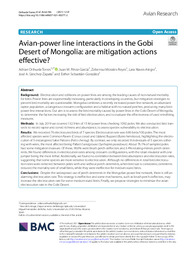Please use this identifier to cite or link to this item:
https://hdl.handle.net/11000/33907Full metadata record
| DC Field | Value | Language |
|---|---|---|
| dc.contributor.author | Orihuela Torres, Adrian Antonio | - |
| dc.contributor.author | Pérez‑García, Juan M. | - |
| dc.contributor.author | Morales-Reyes, Zebensui | - |
| dc.contributor.author | Naves Alegre, Lara | - |
| dc.contributor.author | Sánchez Zapata, José Antonio | - |
| dc.contributor.author | Sebastián-González, Esther | - |
| dc.contributor.other | Departamentos de la UMH::Biología Aplicada | es_ES |
| dc.date.accessioned | 2024-11-18T12:19:53Z | - |
| dc.date.available | 2024-11-18T12:19:53Z | - |
| dc.date.created | 2021-08-21 | - |
| dc.identifier.citation | Avian Research, (2021) 12:41 | es_ES |
| dc.identifier.issn | 2053-7166 | - |
| dc.identifier.uri | https://hdl.handle.net/11000/33907 | - |
| dc.description.abstract | Background: Electrocution and collisions on power lines are among the leading causes of non-natural mortality for birds. Power lines are exponentially increasing, particularly in developing countries, but mitigation strategies to prevent bird mortality are questionable. Mongolia combines a recently increased power line network, an abundant raptor population, a dangerous crossarm confguration and a habitat with no natural perches, producing many birdpower line interactions. Our aim is to assess the bird mortality caused by power lines in the Gobi Desert of Mongolia, to determine the factors increasing the risk of bird electrocution, and to evaluate the efectiveness of used retroftting measures. Methods: In July 2019 we covered 132.9 km of 15 kV power lines checking 1092 poles. We also conducted bird tran‑ sects to record raptor and corvid richness and abundance, to assess species vulnerability to electrocution. Results: We recorded 76 electrocuted birds of 7 species. Electrocution rate was 6.96 birds/100 poles. The most afected species were Common Raven (Corvus corax) and Upland Buzzard (Buteo hemilasius), highlighting the electro‑ cution of 5 endangered Saker Falcons (Falco cherrug). By contrast, we only recorded 8 individuals of 5 species collid‑ ing with wires, the most afected being Pallas’s Sandgrouse (Syrrhaptes paradoxus). About 76.1% of sampled poles had some mitigation measure. Of these, 96.6% were brush perch defectors and 3.4% rotating-mirrors perch deter‑ rents. We found diferences in electrocution rates among crossarm confgurations, with the strain insulator with one jumper being the most lethal. Additionally, we found no correlation between bird abundance and electrocution rates, suggesting that some species are more sensitive to electrocution. Although no diferences in total bird electrocu‑ tion rates were detected between poles with and without perch deterrents, when bird size is considered, deterrents reduced the mortality rate of small birds, while they were inefective for medium-sized birds. Conclusions: Despite the widespread use of perch deterrents in the Mongolian power line network, there is still an alarming electrocution rate. This strategy is inefective and some mechanisms, such as brush perch defectors, may increase the electrocution rate for some medium-sized birds. Finally, we propose strategies to minimize the avian electrocution rate in the Gobi Desert. | es_ES |
| dc.format | application/pdf | es_ES |
| dc.format.extent | 9 | es_ES |
| dc.language.iso | eng | es_ES |
| dc.publisher | KeAi Communications | es_ES |
| dc.rights | info:eu-repo/semantics/openAccess | es_ES |
| dc.rights | Attribution-NonCommercial-NoDerivatives 4.0 Internacional | * |
| dc.rights.uri | http://creativecommons.org/licenses/by-nc-nd/4.0/ | * |
| dc.subject | Collision | es_ES |
| dc.subject | Crossarm confguration | es_ES |
| dc.subject | Electrocution | es_ES |
| dc.subject | Electric infrastructures | es_ES |
| dc.subject | Perch deterrent | es_ES |
| dc.subject | Power line network | es_ES |
| dc.subject | Raptor | es_ES |
| dc.subject.other | CDU::5 - Ciencias puras y naturales::57 - Biología | es_ES |
| dc.title | Avian‑power line interactions in the Gobi Desert of Mongolia: are mitigation actions efective? | es_ES |
| dc.type | info:eu-repo/semantics/article | es_ES |
| dc.relation.publisherversion | https://doi.org/10.1186/s40657-021-00277-2 | es_ES |

View/Open:
30.pdf
1,83 MB
Adobe PDF
Share:
.png)
